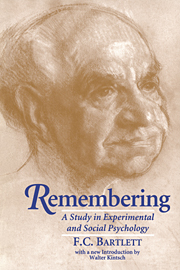Book contents
- Frontmatter
- Contents
- Biography of Sir Frederic C. Bartlett
- Introduction by Walter Kintsch
- Preface
- PART I EXPERIMENTAL STUDIES
- Chapter I Experiment in Psychology
- Chapter II Experiments on Perceiving
- Chapter III Experiments on Imaging
- Chapter IV Experiments on Remembering: (a) The Method of Description
- Chapter V Experiments on Remembering: (b) The Method of Repeated Reproduction
- Chapter VI Experiments on Remembering: (c) The Method of Picture Writing
- Chapter VII Experiments on Remembering: (d) The Method of Serial Reproduction; I
- Chapter VIII Experiments on Remembering: (e) The Method of Serial Reproduction; II. Picture Material
- Chapter IX Perceiving, Recognising, Remembering
- Chapter X A Theory of Remembering
- Chapter XI Images and their Functions
- Chapter XII Meaning
- PART II REMEMBERING AS A STUDY IN SOCIAL PSYCHOLOGY
- Index
- Plate section
Chapter VII - Experiments on Remembering: (d) The Method of Serial Reproduction; I
Published online by Cambridge University Press: 04 August 2010
- Frontmatter
- Contents
- Biography of Sir Frederic C. Bartlett
- Introduction by Walter Kintsch
- Preface
- PART I EXPERIMENTAL STUDIES
- Chapter I Experiment in Psychology
- Chapter II Experiments on Perceiving
- Chapter III Experiments on Imaging
- Chapter IV Experiments on Remembering: (a) The Method of Description
- Chapter V Experiments on Remembering: (b) The Method of Repeated Reproduction
- Chapter VI Experiments on Remembering: (c) The Method of Picture Writing
- Chapter VII Experiments on Remembering: (d) The Method of Serial Reproduction; I
- Chapter VIII Experiments on Remembering: (e) The Method of Serial Reproduction; II. Picture Material
- Chapter IX Perceiving, Recognising, Remembering
- Chapter X A Theory of Remembering
- Chapter XI Images and their Functions
- Chapter XII Meaning
- PART II REMEMBERING AS A STUDY IN SOCIAL PSYCHOLOGY
- Index
- Plate section
Summary
INTRODUCTION
All of the methods so far described deal with factors influencing individual observers. They help to show what occurs when a person makes use of some new material which he meets, assimilating it and later reproducing it in his own characteristic manner. Already it is clear, however, that several of the factors influencing the individual observer are social in origin and character. For example, many of the transformations which took place as a result of the repeated reproduction of prose passages were directly due to the influence of social conventions and beliefs current in the group to which the individual subject belonged. In the actual remembering of daily life the importance of these social factors is greatly intensified. The form which a rumour, or a story, or a decorative design, finally assumes within a given social group is the work of many different successive social reactions. Elements of culture, or cultural complexes, pass from person to person within a group, or from group to group, and, eventually reaching a thoroughly conventionalised form, may take an established place in the general mass of culture possessed by a specific group. Whether we deal with an institution, a mode of conduct, a story, or an art-form, the conventionalised product varies from group to group, so that it may come to be the very characteristic we use when we wish most sharply to differentiate one social group from another. In this way, cultural characters which have a common origin may come to have apparently the most diverse forms.
The experiments now to be described were designed to study the effects of the combination of changes brought about by many different individuals.
- Type
- Chapter
- Information
- RememberingA Study in Experimental and Social Psychology, pp. 118 - 176Publisher: Cambridge University PressPrint publication year: 1995



